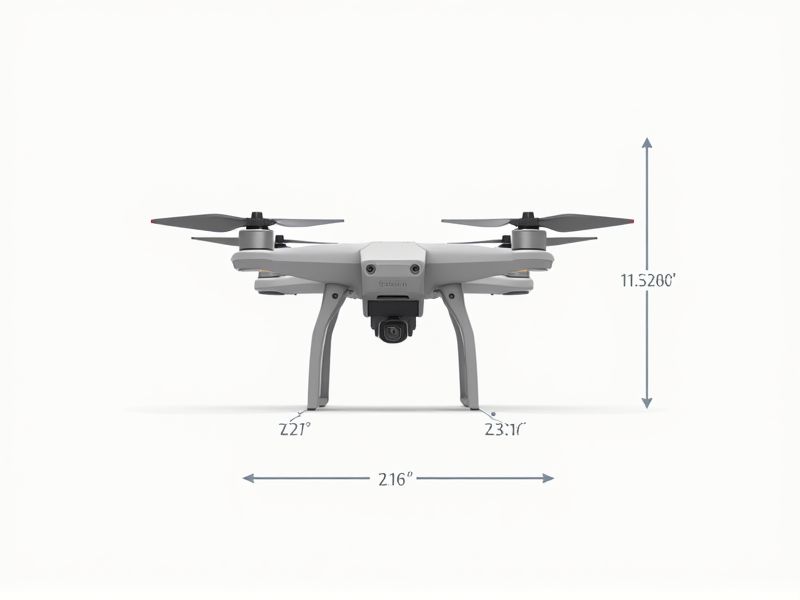
Drone dimensions can vary significantly depending on their intended use, but most consumer drones typically have a diagonal size (measured from propeller to propeller) ranging between 250mm and 400mm. For example, a popular model like the DJI Mavic Air 2 measures about 183x253x77 mm (LxWxH) when unfolded. Smaller drones, often used indoors or for beginners, can be as compact as 100x100x40 mm. If you need a drone for a specific application, it's helpful to check its product specifications, as dimensions are directly related to portability and flight stability.
Payload Capacity
The payload capacity of drones significantly impacts their functionality and application across various industries. For instance, commercial drones can typically carry payloads ranging from 2 to 15 kilograms, while specialized models designed for heavy lifting can support up to 300 kilograms. This increased capacity enables the transportation of critical supplies, such as medical equipment in remote areas or agricultural pesticides over vast fields. When selecting a drone, consider your specific needs; choosing one with the appropriate payload capacity ensures optimal performance and efficiency for your tasks.
Wingspan
The standard wingspan for commercial drones typically ranges from 3 to 10 feet, influencing flight stability and payload capacity. A larger wingspan can enable longer flight durations, often exceeding 30 minutes, and improved aerodynamic efficiency. For instance, drones with a 6-foot wingspan are capable of carrying payloads up to 10 pounds while maintaining optimal performance. Understanding the relationship between wingspan and overall drone capabilities is essential for both hobbyists and professional users aiming to maximize flight efficiency.
Fuselage Length
The fuselage length of a drone significantly influences its aerodynamic performance and payload capacity. For instance, most commercial drones have a fuselage length ranging from 40 to 150 centimeters, which affects stability during flight and overall handling. A longer fuselage can accommodate larger batteries and additional equipment, potentially extending flight time and enhancing operational capabilities. Understanding the ideal fuselage length for your drone type is crucial for optimizing its flight efficiency and versatility in various applications.
Height
The standard for drone focus typically prioritizes a maximum operational altitude of 400 feet above ground level, enhancing safety and compliance with aviation regulations. This height limit ensures that drones can effectively perform tasks such as aerial photography, surveying, and agriculture without interfering with manned aircraft. It is vital for users to check local regulations, as some areas may impose stricter height restrictions. Always monitor your drone's altitude carefully to maintain optimal performance and adherence to safety guidelines.
Rotor Diameter
The rotor diameter of a drone is a critical factor influencing its performance and stability. Typically, drone rotor diameters range from 5 inches to over 30 inches, depending on the intended application, such as racing or aerial photography. A larger rotor diameter generally improves lift capabilities, allowing for better stability and efficiency, especially in windy conditions. For optimal flight performance, consider selecting a drone with a rotor diameter that matches your specific needs, as this can significantly impact maneuverability and payload capacity.
Weight
The standard weight for consumer drones typically ranges from 250 grams to 25 kilograms, impacting both portability and flight performance. For instance, drones weighing under 250 grams often fall into the "no registration" category, making them accessible for casual users. Heavier drones, particularly those between 2 to 7 kilograms, can carry advanced cameras and sensors, offering more stability and longer flight times. Maintaining your drone within the 1 to 2-kilogram range can provide an ideal balance of ease of use and functional capabilities, making it suitable for both hobbyists and commercial applications.
Endurance Time
Endurance time is a critical specification for drones, directly influencing their operational range and effectiveness. Many high-performance drones boast endurance times exceeding 30 minutes, allowing for extensive aerial surveys, inspections, and recreational flying without frequent recharges. For commercial applications, models like the DJI Matrice 300 RTK can achieve up to 55 minutes of flight time, significantly enhancing productivity in industries such as agriculture and construction. When selecting a drone, consider how endurance time aligns with your specific needs for efficiency and task completion.
Range
The standard range of consumer drones typically spans from 1 to 10 kilometers, depending on the model and technology used. High-end commercial drones can achieve ranges exceeding 20 kilometers, making them ideal for applications such as surveying and agriculture. Optimal range is influenced by factors like battery capacity, signal strength, and environmental conditions. For effective operation, you should always consider your drone's specifications and local regulations governing flight distances.
Speed
Drones designed with a focus on speed can reach velocities exceeding 100 miles per hour, significantly enhancing their operational capabilities. These high-speed models often feature lightweight materials, such as carbon fiber, to optimize performance without sacrificing stability. Equipped with powerful motors, the fastest commercial racing drones can accelerate from 0 to 60 mph in just 2 seconds, making them ideal for competitive racing events. Investing in a high-speed drone can elevate your aerial photography or videography, allowing you to capture dynamic shots with minimal motion blur.
Battery Size
The battery size of a drone significantly impacts its flight time and payload capacity, with most consumer models featuring batteries ranging from 1,500 mAh to 6,000 mAh. A larger battery, such as a 5,000 mAh unit, can provide up to 30 minutes of flight time, while smaller batteries may only allow for 10 to 15 minutes. Optimal battery performance is crucial for applications like aerial photography, where extended flight times are necessary to capture high-quality footage. Investing in a drone with a robust battery size ensures that operators can maximize their operational efficiency and meet their specific flight needs.
